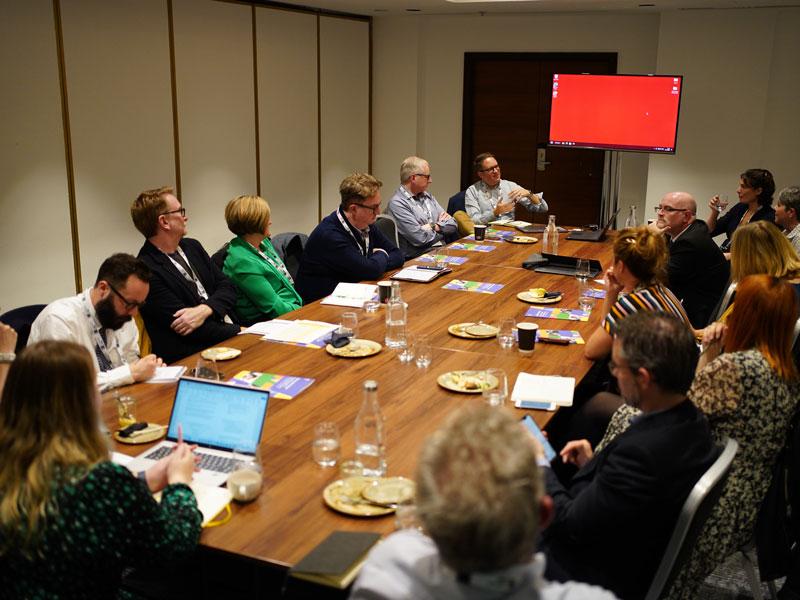
Defining student success: the search for new metrics

What does student success look like in the 21st century? As education is transformed by digitalisation, and the labour market demands new skills from graduates, the current metrics for defining student success are under pressure to evolve.
Some metrics, such as continuation and completion, are evergreen. But to get a clear picture of student success and to tailor teaching and curricula to support that, universities are looking to broaden their metrics, with many higher education leaders advocating a more personalised approach to defining success.
At a round table hosted by Adobe at THE Campus Live UK&IE, leaders from across the UK’s higher education sector shared their experiences and insights into student success and discussed the need for metrics that were more relevant to today’s students and the modern university’s mission.
There was a broad agreement that more personalised, student-led approaches were needed. Tim Quine, deputy vice-chancellor of education and student experience at the University of Exeter, argued that what is currently presented in the Teaching Excellence Framework (TEF) can be reductive.
“What we need is that rich picture of each student to be captured in a way that they can present to the outside world,” he said. “Once we start saying we’ve got to submit to TEF, you take all these rich pictures and turn them into two pixels. How much energy do we put into supporting students to develop their journey and describe it, and the ways that we can watch that journey and give them good advice on where they want to develop new attributes and new skills and give them new challenges?” The digitalisation of student engagement helped universities maintain clear lines of communication with students, allowing institutions to survey their students to learn what they considered a success.
The concept of self-efficacy surveys was appealing. “A key element is speaking to our students and understanding them,” said Florence Harvey, head of student success at the University of Southampton. “That idea of measuring the success of universities by outcomes or purely by graduate salaries negates that broader understanding about what universities are, both from a civic perspective and for an individual. If we talk to our students about why they come to the university, what they hope to achieve and what success looks like for them, then we can start to understand what success looks like within our own local contexts and how we support students so that that is something we can achieve.”
While students tended to overrate their aptitudes at the beginning of a course, self-efficacy surveys foregrounded personalisation. Translating this personalisation into a model that is effective for student success requires a robust support strategy. Esther Kent, head of academic and strategic employability at Sheffield Hallam University, said it requires universities to be brave enough to take student feedback onboard and find a way to represent it in their submissions to the TEF.
“We have a student support triangle where every student has an individual academic advisor, student support advisor and careers advisor, so within that triangle, they have three touch points,” Kent said. “It works effectively to a point, but it’s having them used to personalisation.”
Others similarly recognised the tension between their obligations to the TEF and the search for new ways of defining success. “The transformative effect that courses and programmes can have, and the university can have on a student, is not always something that can be put to a number and inserted onto a spreadsheet,” said Mark Andrews, pedagogical evangelist at Adobe.
Some metrics needed to be side-stepped entirely. Sally Charles, innovation learning manager at Robert Gordon University, said that some metrics used to assess her entrepreneurship and innovation programme were in direct conflict with the learning outcomes of the class. Others, such as unicorn status, were fashionable in entrepreneurship education, but not every student’s idea of success, she warned.
Set against the context of a student’s career objectives, the case for greater personalisation and for engaging the student in self-reflection was persuasive. It gave learning objectives a vocational significance and allowed universities to link new learning metrics to the institution’s civic mission. Echoing many around the table, Adam Longcroft, dean of learning and teaching at St Mary’s University, said higher education needed to view student success through a wider lens.
“The challenge is to capture the qualitative articulations of what students are defining as their own gain for themselves,” he said. “That is easy to say, but very difficult to deliver and land, but that is what we are aiming to do.”
The panel:
- Julia Gilmore, branded content manager (EMEA and the Americas), Times Higher Education (chair)
- Mark Andrews, pedagogical evangelist, Adobe
- Sally Charles, innovation learning manager, Robert Gordon University
- Paul Davies, dean, University of South Wales
- Nick Dearden, director of learning and teaching, Staffordshire University
- David Goddard, head of digital student experience, University College London
- Colm Harmon, vice-principal of students, The University of Edinburgh
- Florence Harvey, head of student success, University of Southampton
- Joanna Hendy, director of learning enhancement, Cardiff Metropolitan University
- Jill Holliday, director of academic services and deputy academic registrar, University of Essex
- Deborah Johnston, deputy vice chancellor, London South Bank University
- Esther Kent, head, academic & strategic employability, Sheffield Hallam University
- Adam Longcroft, dean of learning & teaching, St Mary's University
- Bobbi Moore, principal teaching fellow, project lead and digital education lead, University of Southampton
- Tim Quine, deputy vice-chancellor of education and student experience, University of Exeter
Find out more about Adobe’s solutions for higher education.

